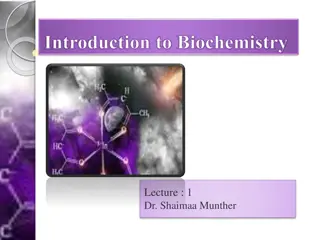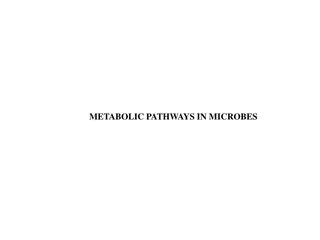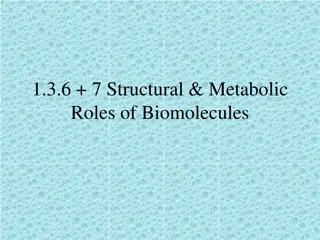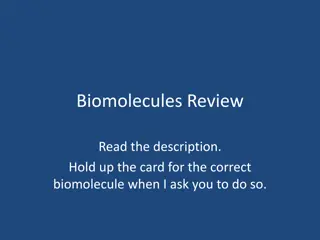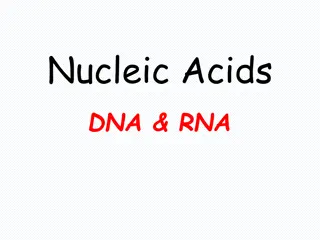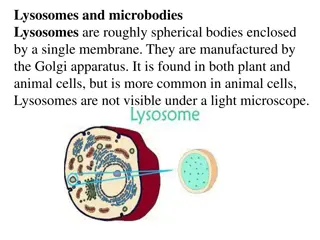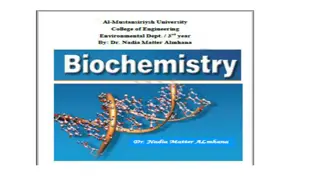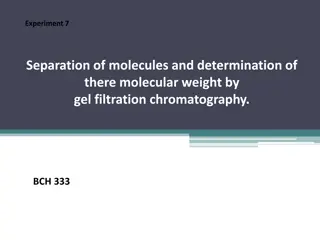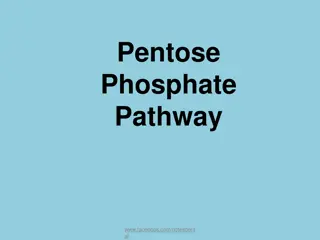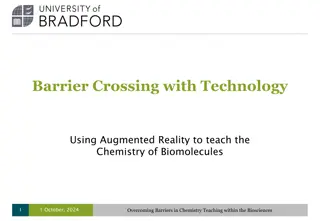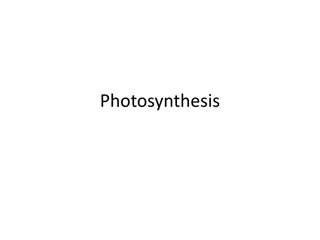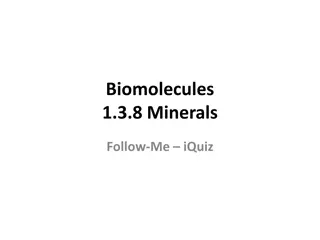Introduction to Biochemistry: Understanding the Chemistry of Life
Biochemistry is the science that delves into the chemical basis of life, focusing on cellular components, biomolecules, metabolism, gene expression, and more. Understanding biochemistry is crucial for comprehending the molecular processes associated with living cells, both in health and disease.
7 views • 58 slides
Understanding Metabolic Pathways in Microbes
Metabolism in living organisms involves anabolism and catabolism, where anabolism generates essential biomolecules for growth using energy, while catabolism breaks down nutrients for energy release. Anabolic processes include synthesis of carbohydrates, lipids, proteins, nucleic acids, and other gro
7 views • 24 slides
Understanding Physicochemical Properties of Drugs
The physicochemical properties of drugs play a crucial role in their pharmacological effects. These properties include physical and chemical characteristics that influence interactions with biomolecules. Solubility, partition coefficient, and dissociation constant are key factors affecting drug beha
1 views • 46 slides
Understanding the Structural Roles of Biomolecules in Living Organisms
Explore the essential roles of carbohydrates, proteins, and lipids in cell structure and function. Learn how cellulose, keratin, myosin, phospholipids, and more contribute to the structural integrity and metabolic activities within living organisms. Discover the significance of these biomolecules in
4 views • 23 slides
Interactive Biomolecules Review Activity
Engage in an interactive biomolecules review where you must identify different biomolecules - carbohydrates, proteins, lipids, and nucleic acids - based on visual cues. Hold up the correct card when prompted for each biomolecule to test your knowledge and understanding of these essential compounds.
0 views • 43 slides
Understanding Carbohydrates: The Essential Biomolecules in Nature
Biomolecules are vital molecules found in all living organisms, primarily composed of carbon along with other elements like hydrogen, oxygen, and nitrogen. Carbohydrates, the most abundant organic molecules in nature, are important sources of energy and serve as structural precursors for various com
0 views • 15 slides
Exploring Nucleic Acids: DNA and RNA Structure and Function
Delve into the world of nucleic acids with a focus on DNA and RNA molecules. Discover the fundamental building blocks, such as nucleotides, and the role they play in genetic information storage and cell function. Learn about the unique characteristics of DNA like its double-helix structure and the s
0 views • 26 slides
Understanding Lysosomes: Functions and Characteristics
Lysosomes are membrane-enclosed organelles containing digestive enzymes that break down various biomolecules. They maintain an acidic internal environment, protecting the cell from enzymatic activity. Lysosomes play a crucial role in cellular waste disposal, macromolecule digestion, and intracellula
0 views • 18 slides
Understanding the Molecular Composition of Living Cells
Living cells are primarily composed of hydrogen, oxygen, nitrogen, carbon, phosphorus, and sulfur, which form the basis of organic biomolecules. Cells have common features such as cytoplasm, cell membranes, and nuclei. Different types of cells exist, ranging from eukaryotic with organized nuclei to
0 views • 9 slides
Gel Filtration Chromatography: Separation and Molecular Weight Determination
Gel filtration chromatography is a method used for separating proteins based on their molecular weights. This experiment aims to teach students the principles of gel filtration chromatography and provide hands-on experience in the lab. By utilizing a stationary phase of porous beads and a mobile pha
0 views • 22 slides
Understanding the Pentose Phosphate Pathway in Metabolism
The Pentose Phosphate Pathway, also known as the Hexose Monophosphate shunt, is an alternative route for glucose metabolism that plays a crucial role in NADPH synthesis, fatty acid production, antioxidant activity, and nucleotide formation. This pathway involves oxidative and non-oxidative phases, r
0 views • 12 slides
Understanding Energy Transformations in Cells
Explore the intricate processes of photosynthesis and cellular respiration, vital for energy production in cells. Discover how radiant energy from the sun is converted into chemical energy like glucose and ATP. Uncover the significance of energy for various metabolic functions in cells, including ac
0 views • 17 slides
Interactive Review Stations for Biology Class
Engage in interactive review stations in biology class by walking around with a partner and answering questions related to biomolecules, enzymes, and DNA replication. Utilize images and prompts at each station to enhance learning and test comprehension. Ensure to complete each station to earn credit
0 views • 31 slides
Enhancing Chemistry Education with Augmented Reality Technology
Augmented reality technology offers innovative solutions to overcome barriers in teaching chemistry within the biosciences. By integrating AR tools such as interactive 3D images and simulations, students can explore the micro-world of biomolecules with higher comprehension and engagement. This appro
0 views • 11 slides
Biochemistry and Chemistry Elective Courses Overview at SRCASW
The Shaheed Rajguru College of Applied Sciences for Women offers elective courses in Biochemistry and Chemistry. The Biochemistry course covers biomolecules like amino acids, proteins, carbohydrates, lipids, and nucleic acids, emphasizing their properties and functions. It also includes practical ex
0 views • 19 slides
Understanding Photosynthesis: Importance, Process, and Pigments
Explore the crucial process of photosynthesis in plants, from the absorption of sunlight to the production of biomolecules. Discover the significance of leaf pigments, light absorption, and why leaves are green. Delve into the types of pigments and the reasons behind leaves changing colors. Uncover
0 views • 22 slides
Understanding Polymeric Prodrug Coupling Methods
Coupling methods in polymeric prodrugs involves the conjugation of drugs or biomolecules with polymers through stable bond linkages like ester, amide, or disulfide bonds. Different coupling agents and reactive groups are utilized to achieve successful conjugation, with recent advancements focusing o
0 views • 23 slides
Understanding Biomolecules and Minerals: A Quiz Challenge
Test your knowledge of biomolecules and minerals with this interactive quiz. Identify monosaccharides, understand the role of vitamins and minerals in human health, and learn about common disorders associated with nutrient deficiencies. Challenge yourself and enhance your understanding of essential
0 views • 50 slides
